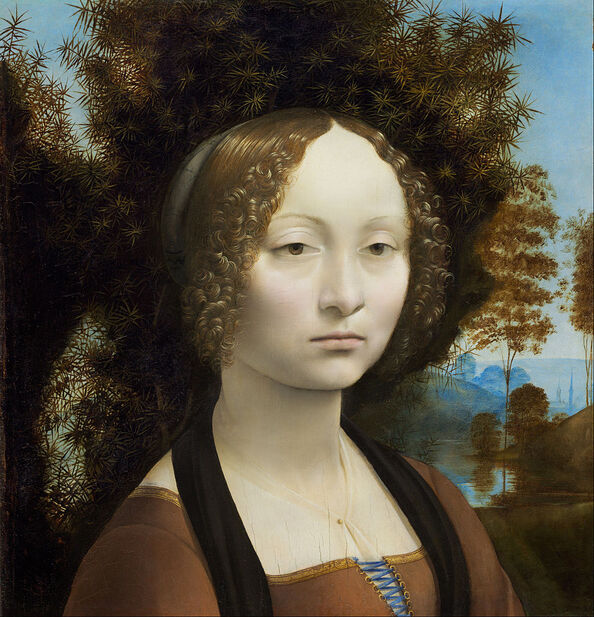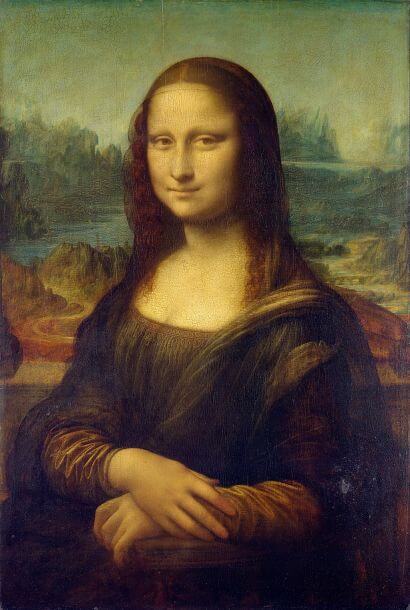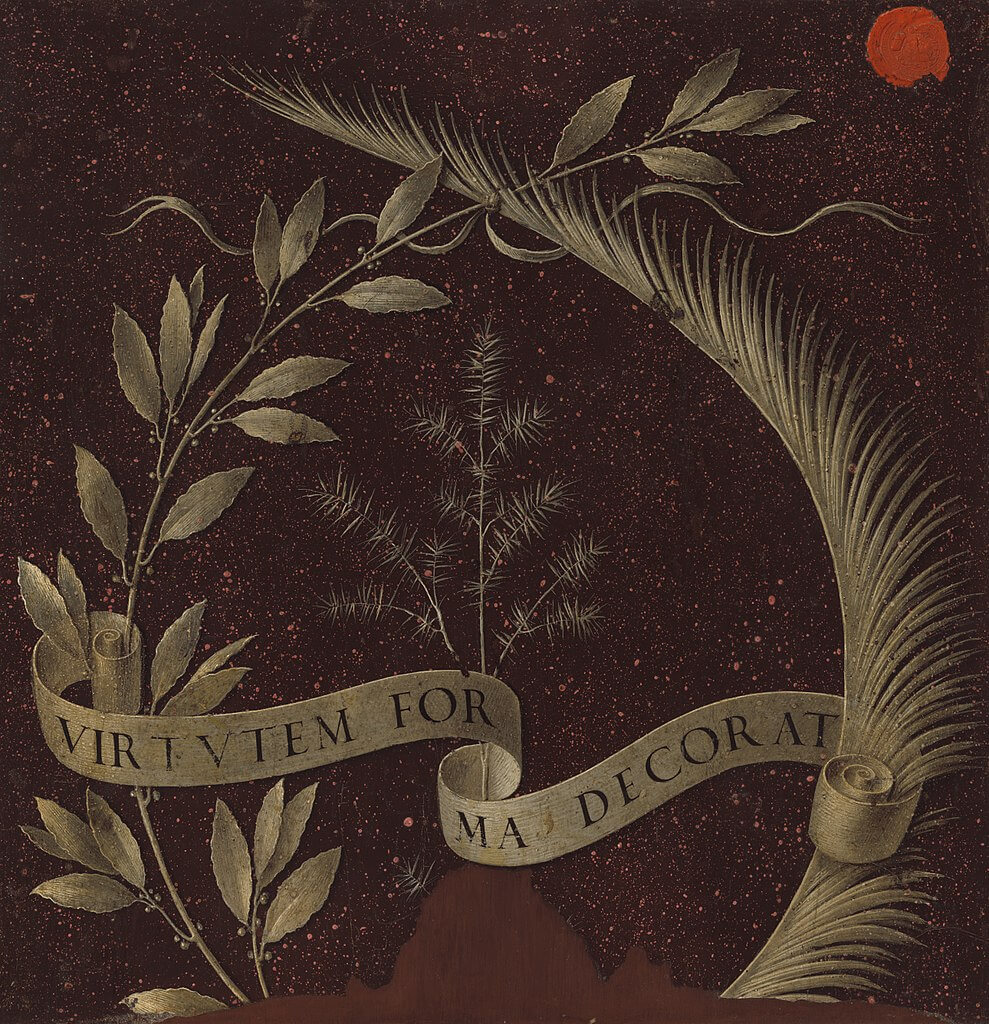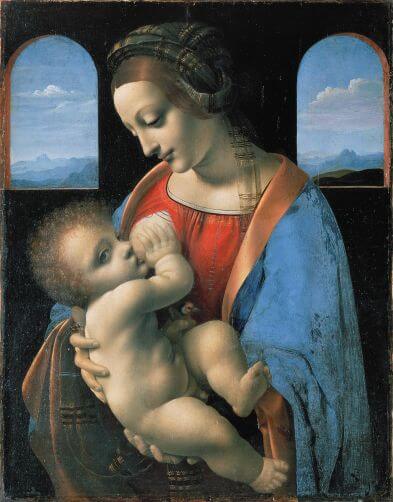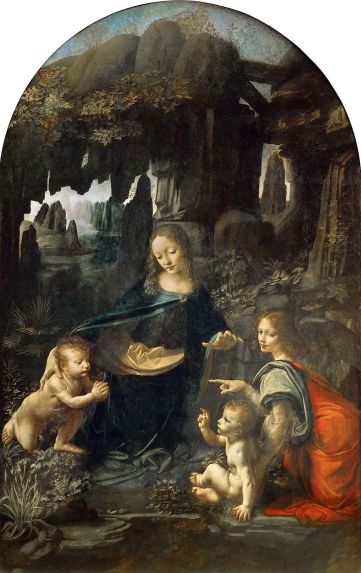|
Where? Gallery 6 of the National Gallery of Art
When? 1474 Commissioned for? Most likely, either the engagement or marriage of Ginevra de’ Benci. What do you see? The 16- or 17-year old Ginevra de Benci is painted. She is wearing a brown dress with blue laces and gold edges, and a black scarf. Below the dress she wears a subtle white blouse with a golden pin. She has a porcelain-like skin and her hair is styled in ringlets. Her expression is, one the one hand, a bit grumpy, and on the other hand, she seems proud. Her eyes emphasize this. Her left eye (for the viewer) is looking at the viewer, but her right eye seems to be looking down on something. Experts have interpreted the facial expression of Ginevra as an indication that she is not happy with the (upcoming) marriage. Note that Ginevra has only light eyebrows. Shaving the eyebrows was common at that time for women and can also be seen in the Mona Lisa by Leonardo da Vinci. Behind Ginevra is a juniper bush. The halo of spikes from the juniper leaves contrast nicely with the depiction of Ginevra. In the right background are the mountains, trees, water, a small town, and the hazy sky, which are typical for Leonardo da Vinci’s style.
Back of the painting: On the back of this painting is another painting from Leonardo da Vinci, called Wreath of Laurel, Palm, and Juniper. It shows a juniper sprig, with a circular arrangement of palm and laurel around it. It also includes the inscription “Virtutem Forma Decorat”, which means “beauty adorns virtue.”
Backstory: This painting was created to commemorate Ginevra de’ Benci’s engagement or marriage to Luigi di Bernardo Niccolini. Sources have shown that the wedding between both of them took place on January 15, 1474. Bernardo Niccolini was twice the age of Ginevra. During the Renaissance, women were typically only depicted when they got engaged or married.
This is the first known portrait that Leonardo da Vinci painted and the only painting of him in the Americas that is available for public viewing. It was bought in 1967 for $5 million. Symbolism: The juniper bush represents chastity, which was considered to be one of the most important moral standard for women in the Renaissance. At the same time, juniper is a reference to Ginevra’s name as juniper translates into Italian as “ginepro”. The laurel and palm on the back of the painting symbolize, respectively, the intelligence and moral values of Ginepra. However, the laurel and palm were also the personal emblem of Bernardo Bembo, who was thought to have a platonic affair with Ginevra. Bernardo Bembo was the Venetian ambassador to Florence, and he probably commissioned the back of this painting (and according to some also the front of the painting, but this is not proven). Who is Ginevra de’ Benci? Ginevra de’ Benci (born in 1457 or 1458) was the daughter of a wealthy Florentine banker. She was considered to be one of the most intellectual people of her time and was a poet. Later in her life, Ginevra was exiled at her own request because of an unknown illness and tragic love affair. Who is Leonardo da Vinci? Leonardo da Vinci (1452-1519) was born in the Italian village of Anchiano, which was very close to Vinci, which is where he got his name from. He was an architect, astronomer, engineer, inventor, mathematician, musician, painter, writer, and much more. Leonardo da Vinci is known to be one of the biggest multi-talented people that the world has ever seen. He created this painting while he was still a student of Andrea del Verrocchio. Other well-known paintings by Leonardo da Vinci include his Madonna Litta in the Hermitage Museum and Virgin of the Rocks in the Louvre.
Fun fact: About one-third of this painting is missing. At some point in history, someone cut off the lower third of the painting, probably because it was damaged. Based on a drawing of Leonardo da Vinci, it is believed that the part that is cut off probably shows Ginevra folding or crossing her hands in her lap. It is a pity that this part is missing as Leonardo was a specialist in drawing hands. With his diverse interests, he was obsessed by the anatomical correctness when he painted parts of the human body. Ginevra was possibly holding a flower in her hand to symbolize devotion.
Interested in a copy for yourself? Poster or canvas of Ginevra de' Benci; poster of Wreath of Laurel, Palm, and Juniper.
Written by Eelco Kappe
References:
2 Comments
Anonymous
5/23/2018 02:34:39 pm
Why did part of the Ginevra de Benci get cut off? If there is no known reason, than what do the experts think?
Reply
TripImprover
5/30/2018 09:16:11 am
This is a great question! We have not found conclusive evidence on this, but there are two possible reasons.
Reply
Leave a Reply. |
Categories
All
|
- Home
- Blog
-
Museums
- Alte Pinakothek
- Art Institute of Chicago
- Baltimore Museum of Art
- Barber Institute of Fine Arts
- Bargello
- Barnes Foundation
- British Museum
- Church of Sant’Anastasia
- Cleveland Museum of Art
- Courtauld Institute of Art
- Detroit Institute of Arts
- Frans Hals Museum
- Galleria Borghese
- Gallerie dell'Accademia
- Getty Museum
- Guggenheim
- Hermitage Museum
- Kunsthistorisches Museum
- Kunstmuseum Basel
- Legion of Honor Museum
- Louvre
- Mauritshuis
- Metropolitan Museum of Art
- Musee d’Orsay
- Museum of Fine Arts in Boston
- Museum of Modern Art
- National Gallery in London
- National Gallery of Art
- National Museum in Poznań
- Norton Simon Museum
- Ny Carlsberg Glyptotek
- Palace of Versailles
- Palazzo Pitti
- Palazzo Vecchio
- Petit Palais
- Philadelphia Museum of Art
- Prado
- Pushkin Museum
- Ravenna Art Museum
- Rijksmuseum
- San Diego Museum of Art
- Santa Maria delle Grazie
- St. Peter's Basilica
- Städel Museum
- Statens Museum for Kunst
- Tate Britain
- Tate Modern
- Timken Museum of Art
- Uffizi
- Vatican Museums
- Wallace Collection
-
Artists
- Altdorfer
- Anguissola
- Berlin Painter
- Bosch
- Botticelli
- Boucher
- Bronzino
- Bruegel the Elder
- Brunelleschi
- Cabanel
- Caillebotte
- Canova
- Caravaggio
- Carpeaux
- Cezanne
- Cimabue
- David
- Degas
- Delacroix
- De Maria
- Donatello
- El Greco
- Fontana
- Fra Angelico
- Fragonard
- Gauguin
- Gentileschi
- Gericault
- Gonzalez-Torres
- Goya
- Hals
- Hogarth
- Hokusai
- Ingres
- Leonardo da Vinci
- Lippi, Filippo
- Longhi, Barbara
- Lorrain
- Makovsky
- Manet
- Massys
- Matisse
- Merian
- Michelangelo
- Mochi
- Modigliani
- Monet
- Panini
- Parmigianino
- Perugino
- Picasso
- Pisanello
- Raphael
- Rembrandt
- Renoir
- Reynolds
- Rivera
- Rodin
- Rubens
- Scultori
- Seurat
- Steen
- Tintoretto
- Titian
- Toulouse-Lautrec
- Turner
- Uccello
- Van der Weyden
- Van Dyck
- Van Eyck
- Van Gogh
- Van Hemessen
- Vasari
- Velazquez
- Vermeer
- Veronese
- Vigée Le Brun
-
Locations
- Books
- About Us

